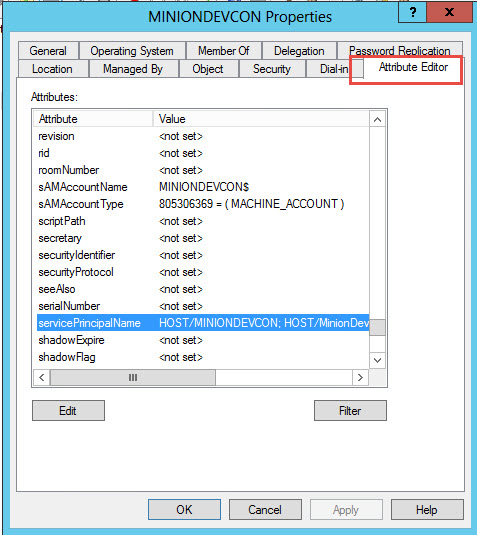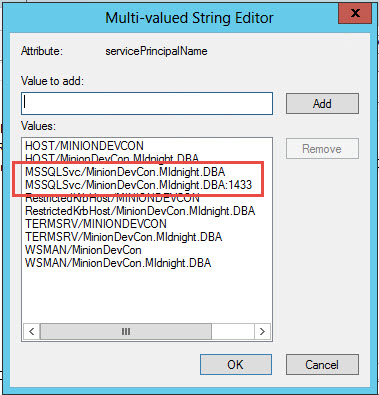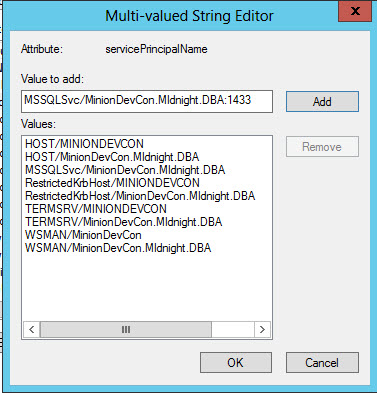When you’re in an environment where you need to add user accounts to different servers on a regular basis, it can be a pain to manage the requests because you have to connect to each server, and either use the GUI to add the account, or write the statement yourself. Now, this normally isn’t a big deal, but if you have to do it several times a day that extra time it takes to go through the steps can start to get old.
So here I’ve written a stored procedure that lets you manage the process from a single location. Now, I’m going to caution you up front that this SP is run from a server where the service account already has admin rights on the servers you’re targeting, so you need to make sure this SP is locked down. Make sure that only DBAs you trust and who are responsible can run this. And if you can, make sure even the ones you trust can’t alter it because it logs its actions and you don’t want anyone being able to turn the logging off.
Ok, you’ve been warned and I don’t want any lawsuits or emails telling me that someone did something that messed things up in your shop because it’s all on you. And while I’ve tested this and run it in a few locations, make sure you test it yourself first before relying on it for any real production scenario.
The legal stuff is out of the way so let’s get into the details of the SP itself.
CREATE PROCEDURE dbo.AddServerPerms
@ServerName varchar(200),
@Action varchar(10),
@UserAcct varchar(100) = 'domain\SMcCown',
@Run bit = 0
AS
/*
This SP allows you to add/drop a user to sa on any box you like. It makes the process easier than connecting to the server each time.
Of course, you should always be careful about adding sa accts to servers so you should lockdown the use of this SP to only DBAs that you trust,
and who are responsible.
This SP also logs its actions so you can see which accts were added/dropped, when, and by whom.
This is also meant to be run from an acct that currently has sa on the server.
So replace the Execute as stmt with the acct of your choice.
This is the log table that needs to be in place before running this SP.
CREATE TABLE dbo.SASecurityLog
(
ID int identity(1,1),
ExecutionDateTime datetime,
ServerName varchar(200),
AcctName nvarchar(200),
Action varchar(10),
Code nvarchar(1000),
RunBy nvarchar(200)
)
*/
Execute as Login = 'sa';
DECLARE @SQL varchar(400),
@TotalSQL varchar(1000),
@TotalDropSQL varchar(1000),
@DropSpidSQL varchar(200),
@RunErrors nvarchar(max),
@Result varchar(10);
If UPPER(@Action) = 'ADD'
BEGIN
SET @SQL = 'CREATE LOGIN [' + @UserAcct + '] FROM WINDOWS; ALTER SERVER ROLE [sysadmin] ADD MEMBER [' + @UserAcct + '];'
END
If UPPER(@Action) = 'DROP'
BEGIN --Drop
SET @SQL = 'DROP LOGIN [' + @UserAcct + '];';
--------------------------------------------------------------------------
-----------------------BEGIN Get SPIDs------------------------------------
--------------------------------------------------------------------------
--Get SPIDs to kill.
SET @DropSpidSQL = 'SELECT SPID from sys.sysprocesses WHERE loginame = ''' + @UserAcct + ''';';
CREATE TABLE #SPIDs(col1 varchar(1000));
SET @TotalDropSQL = 'sqlcmd -S "' + @ServerName + '" -Q "' + @DropSpidSQL + '"'
INSERT #SPIDs(col1)
EXEC xp_cmdshell @TotalSQL;
DELETE #SPIDs
where col1 like '%--%'
OR col1 like '%rows affected%'
OR col1 IS NULL;
--------------------------------------------------------------------------
-----------------------END Get SPIDs--------------------------------------
--------------------------------------------------------------------------
--------------------------------------------------------------------------
-----------------------BEGIN Drop SPIDs-----------------------------------
--------------------------------------------------------------------------
----You can't drop a login if it's currently logged in, so here's where we
----drop all the SPIDs for the current user first.
----There's more than one way to do this. I chose this one because I didn't
----want to cram all this cursor syntax into D-SQL, and I didn't want to require
----a script on the drive to be managed. While that may be a cleaner way to code
----this solution, this method is more portable and doesn't require any extra setup.
DECLARE @currSPID varchar(100);
DECLARE SPIDs CURSOR
READ_ONLY
FOR SELECT col1 FROM #SPIDs
OPEN SPIDs
FETCH NEXT FROM SPIDs INTO @currSPID
WHILE (@@fetch_status <> -1)
BEGIN
SET @DropSpidSQL = 'KILL ' + @currSPID + ';'
SET @TotalDropSQL = 'sqlcmd -S "' + @ServerName + '" -Q "' + @DropSpidSQL + '"'
EXEC xp_cmdshell @TotalDropSQL;
--print @TotalDropSQL
FETCH NEXT FROM SPIDs INTO @currSPID
END
CLOSE SPIDs
DEALLOCATE SPIDs
DROP TABLE #SPIDs;
--------------------------------------------------------------------------
-----------------------END Drop SPIDs-------------------------------------
--------------------------------------------------------------------------
END --Drop
--------------------------------------------------------------------------
-----------------------BEGIN Log Action-----------------------------------
--------------------------------------------------------------------------
INSERT dbo.SASecurityLog
(ExecutionDateTime, ServerName, AcctName, Action, Code, RunBy)
SELECT GETDATE(), @ServerName, @UserAcct, @Action, @SQL, SUSER_SNAME();
If @Run = 0
BEGIN
SELECT @SQL AS AcctSQL;
END
--------------------------------------------------------------------------
-----------------------END Log Action-------------------------------------
--------------------------------------------------------------------------
--------------------------------------------------------------------------
-----------------------BEGIN Run Action-----------------------------------
--------------------------------------------------------------------------
If @Run = 1
BEGIN --Run = 1
CREATE TABLE #Results(ID tinyint identity(1,1), col1 nvarchar(2000));
SET @TotalSQL = 'sqlcmd -S "' + @ServerName + '" -Q "' + @SQL + '"'
INSERT #Results(col1)
EXEC xp_cmdshell @TotalSQL;
--------------BEGIN Get Run Errors------------------------
SELECT @RunErrors = STUFF((SELECT ' ' + col1
FROM #Results AS T1
ORDER BY T1.ID
FOR XML PATH('')), 1, 1, '')
FROM #Results AS T2;
If @RunErrors IS NULL
BEGIN
SET @Result = 'OK';
END
If @RunErrors IS NOT NULL
BEGIN
SET @Result = 'FAILED';
END
--------------END Get Run Errors---------------------------
END --Run = 1
--------------------------------------------------------------------------
-----------------------END Run Action-------------------------------------
--------------------------------------------------------------------------
select TOP(1) @Result AS Result, @RunErrors AS Errors, * from dbo.SASecurityLog ORDER BY ExecutionDateTime DESC;
Now there’s the code for you to use at your leisure. I’m going to discuss some important parts below by line number.
4: You want to be able to use the same SP to add or drop the acct so you can pass the action in.
26: I’ve set this up to run as sa because the service account on the central box has sysadmin on all the servers in the shop. A good scenario for this is when you have a server that’s running a performance app and needs to have sysadmin on all your SQL boxes. I’ll discuss the security implications of this in a section below.
33-39: Depending on the action you take, create the proper syntax.
44-52: There’s more than one way to do these next couple sections of code. I chose this one because I didn’t want there to be any external setup. You should just be able to install the SP and start using it. So here I’m getting the list of SPIDs taken up by the acct on the target server. You can’t drop a user acct if it’s currently logged in. So getting the list of SPIDs to delete and then cursoring through them to kill them is what we’re doing here and in the next couple sections. It’s possible that one of the SPIDs could disconnect and another take it’s place on the server between the time that you get the SPID list and when it gets killed, but it’s unlikely.
66-82: This is the cursor that kills the SPIDs for the current user from the target server. Again, this could be done a different way and if you really don’t like this then rewrite this section.
90-96: We’re logging the action before we run it. It’s important to log the action before the SP gets a chance to error out for some reason.
103-108: This is where we actually run the stmt against the target server. Notice we’re inserting the EXEC stmt into a #table so we can capture the results. If the stmt is a success it returns NULL so it’s easy to see if it failed.
110-122: If the stmt fails for any reason we captured the error in the previous section so we can put those results into a var and use that to set a status. The use of STUFF here is how I commonly do this and it requires the ID column, so if you do this on your own, the code is easy to paste into another SP.
128: Return the results back to the user.
Account Security
Managing accounts in an enterprise can be time consuming, and the more servers you have, the more time consuming it can be. This is why a lot of shops opt for using a single service account for SQL services. However, this is a very dangerous practice because now you have a single account that runs every server in your network so if there’s a security breach, you have a big problem. You have many processes running under this account so there are literally hundreds, if not thousands of opportunities for an attacker to do damage.
However, sometimes it’s necessary to run a centralized management server with an account, and give that account sysadmin on each SQL Server. Quite often 3rd party performance monitors need these elevated rights. There’s a difference though between having a single account with sa and having all the servers running under the same acct. In the centralized server scenario, the only processes running on that account are the ones for the application, and often they’ll be running only on the central server. Therefore, there won’t be any linked servers, jobs, SPs, or anything else running under that account. So it’s more unlikely that you’ll have a breach against that account. It can also be locked down so only the DBAs know it whereas often times many people know the service account passwords. And again, there are many chances for security to get compromised with all of the processes that are likely running under it.
It’s also easier to change the password for that single centralized service account as you don’t have to change it across 100 servers. So you’re most likely going to be able to adhere to better security principals.
Now, for the record… you should never run all your services under the same user account. Always take the extra effort to have a separate account for each server. And at the very least, you can group the servers by application and have a single service account for each application. It’s not as good as having one for each box, but you’ll at least minimize the damage should you be compromised.





